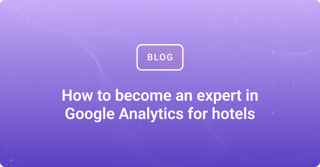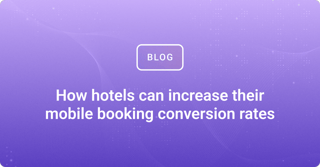The most frequently-cited pain point that hotels experience with their booking engine solution is the lack of personalization functionality. In a recent study run by h2c across more than 9,500 properties globally, the limited ability to personalize was by far the most common issue with 71% of responses mentioning this pain point.
The study also found that 75% of hotel chains use booking engines that are only semi-customizable. This results in a high level of uniformity across the booking experience, with hotels lacking the tools required to compete effectively against online travel agents.
The opportunity here is huge. We know from testing literally thousands of hotel websites that personalization increases conversion rates by at least 16%. According to the h2c report, conversion rate is the clear number one criteria for hoteliers selecting a new booking engine. But without sufficient personalization capabilities, your conversion rate will always be limited.
The good news is you don’t need to go through the pain of switching booking engine to provide a more personalized experience to bookers. Here’s how:
Consistent promotional signposting towards - and on - your booking engine
Seventy four percent of survey respondents mentioned that they used promotional adverts to optimize their booking engine conversion rate. Whether these adverts appear elsewhere on your website, on the wider internet, or offline it’s important to ensure that the promotion a customer is interested in is surfaced consistently throughout their journey - right through to your booking engine. This provides reassurance that when they click to make their booking, they are definitely getting the deal they saw advertised elsewhere.
Recommendation: If you’re running a promotional advert, reflect the key message and imagery all the way through the journey. Update your metasearch call out text, highlight the promotion on your homepage, update any retargeting ads and include the promotional details on your booking engine. If you don’t have the flexibility within your booking engine to regularly update room and rate deals and promotional activities you can always use messaging to do this. Here’s how:
- Create a Nudge Message in the Triptease Message Manager.
- In the Behaviour tab select Specific pages in the Which pages should it display on section and add the URL of your booking engine.
- Add any audience targeting required for your message in the Audience tab. For example if you’re running a promotional campaign to target customers in a particular part of the world (which is key as different regions begin to reopen for travel post-Covid) use location targeting to ensure that people in the right country, state, region or city see the right promotion on your booking engine.
- If someone is already on your booking engine, you don’t want them clicking away. In the Design tab you can set your Button action to Remain on the same page. Make sure you’ve selected this option so that someone who has made it all the way to your booking engine doesn’t click away!

Targeted packages, ancillary sales and upsells
If a customer has made it to your booking engine, this is a really crucial moment to ensure they convert. No wonder then that 56% of survey responses mentioned using packages and ancillary sales as part of their booking engine optimization strategy, with a further 38% mentioning room upsells.
Get the right package or upsell experience in front of the right customer, and your chances of securing that booking are very likely to increase. But not all customers will be looking for the same package or upgrade, and you may want to reserve your very best offers for customers with the highest value to your business. This is where audience targeting comes in.
In the Audience tab of the Triptease Message Builder, you’ll find both Booking engine search targeting criteria as well as Visitor profile targeting criteria. Using the booking engine search criteria first, there are three ways to ensure that your high value packages are being displayed only to high value guests:
- Choose Length of stay targeting and set up a message to target guest searching for more than a certain number of nights. This ensures that only guests booking longer stays will see this message.
- Select Check-in date to target customers running searches for key calendar dates - such as New Year’s Eve, Carnival or Valentine’s Day - when you know your rooms sell for a higher price. These are great opportunities to provide added extras rather than discounts to secure that booking engine conversion.
- Use Party size to target visitors based on the number of guests in a reservation. Again, this is a quick way to ensure that customers who are looking to spend more on their room booking see your very best packages and ancillary services. What’s particularly helpful is that you can tailor these based on the type of group that is booking: Select Family and you could surface free childcare services, or choose Group and offer a local wine tasting tour or suite upgrade.

If you’re more interested in targeted potential guests based on their visitor profile, you can do that too. Location targeting is a great place to start, because you can use data from the Insights Dashboard to work out where your high value customers are coming from.
In the data below, for example, we can see that visitors from Spain have by far the highest average booking value for this hotel. The team at that hotel could create a message that highlights a specific upsell or package for Spanish customers, to display on the booking engine and help them convert. (Top tip: You can create a message with that targeting set up automatically by clicking the purple target icon next to the country name).

Finally, Likelihood to book targeting can be used to personalize and increase booking engine conversions from all kinds of customers. When you select this targeting specification, Triptease will automatically determine how likely a visitor is to book. All you need to think about is what message you'd like them to see.
So if a visitor already looks likely to book it will probably be more profitable to entice them with an upgrade rather than a discount on what they would have purchased anyway. Whereas for visitors with a low likelihood to book, a discount message might be exactly what it takes to persuade them.

Recommendation: Message targeting is a highly impactful way to personalize your booking engine. Remember though that the more targeting specifications you add to a single message, the less customers it will ultimately be displayed to. Consider having multiple messages with just one or two targeting specifications. This will increase the number of customers who will get a personalized experience on your booking engine.
Personalized price comparison information
Another popular booking engine optimisation tool that can easily be personalised is a Price Check Message. Forty three percent of h2c survey responses mentioned price comparison widgets as being part of their booking engine optimization strategy.
The booking engine is one of the most impactful places to provide price comparison information - it removes the customer’s need to click away and check prices elsewhere before they make their booking. With Triptease both the standard Price Check and In Page Price Check messages are fully customizable which means that hotels can edit the direct booking benefits that will be shown to different types of customer.

Recommendation: Don’t just set up one Price Check Message for all customers. Create multiple Price Checks and customize them to target different audiences as you would with any other type of offer message.
Pop-ups and abandonment messaging
Pop-ups and abandonment messages tend to get pretty bad press. It’s true that they can disrupt the user journey, and Google does penalize mobile websites featuring pop-up messages that make the website content less accessible. That said, your booking engine might be one of the key places in the booking journey where a targeted pop-up abandonment message can add value both to you and to your customers.
Most people visit an average of 38 websites before booking a holiday so it’s natural that customers will visit your website and leave several times on the path to purchase. But your direct booking strategy should aim to minimize the time it takes for those potential guests to make the decision to book at your hotel.
If a potential guest has made it to your booking engine to look at rooms and rates, it’s likely they are seriously considering a stay at your hotel. Clicking away at this point often means they’re going to check if they can find a better deal - or clearer guidance about cancellations and cleanliness - for your own rooms on an OTA. A pop-up Exit Message can prevent that from happening and ensure that your customer gets the best deal with you. These messages display only if a user is showing signs that they’re about to leave your website, which means they do disrupt the journey but in a useful way.
Again, customization here is key. Stop high value customers booking elsewhere by sharing your best offers with them when it looks like they’re about to exit the booking engine page. All the targeting specifications discussed above can be used to customize the experience here too.

Recommendation: When used sparingly and carefully, personalized abandonment pop-ups will keep customers on your booking engine. Taking time to understand your customer base and what kind of offers are likely to entice different segments to book will help you secure conversions that you may have otherwise lost to an OTA.
Want to know more about Triptease Messages?
Interested in boosting your direct bookings with Triptease Messages? Contact us here to request a demo or find out more!
Holly is Head of Product Marketing at Triptease.


![[WATCH] COVID-19 and how Asia-Pacific hoteliers can respond in times of crisis](https://www.triptease.com/hs-fs/hubfs/Resources%20-%20feature%20images/Feature-Image_%5B%5BWATCH%5D%20COVID-19%20and%20how%20Asia-Pacific%20hoteliers%20can%20respond%20in%20times%20of%20crisis%5D.png?width=320&height=320&name=Feature-Image_%5B%5BWATCH%5D%20COVID-19%20and%20how%20Asia-Pacific%20hoteliers%20can%20respond%20in%20times%20of%20crisis%5D.png)


![[Masterclass] How Covid-19 is changing hotel UX design](https://www.triptease.com/hs-fs/hubfs/Resources%20-%20feature%20images/Feature-Image_%5B%5BMasterclass%5D%20How%20Covid-19%20is%20changing%20hotel%20UX%20design%5D.png?width=320&height=320&name=Feature-Image_%5B%5BMasterclass%5D%20How%20Covid-19%20is%20changing%20hotel%20UX%20design%5D.png)

